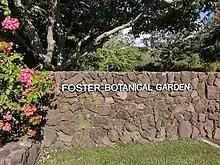
Mary Elizabeth Mikahala Robinson Foster (September 20, 1844 – December 29, 1930) was a Hawaiian philanthropist, and known as the first Hawaiian Buddhist.[1][2] On her death, she donated her substantial gardens to the city of Honolulu, and they later became the Foster Botanical Garden.[3]
Early life and background

Foster was born in 1844 and grew up in Nu‘uanu on Oahu, Hawai‘i, where she attended the Oahu Charity School. She was the eldest of the nine children of Rebecca Prever and John James Robinson. Her mother had French ancestry and Hawaiian ancestry that dates back to ali‘i (chiefs) from Maui and Hawai‘i Island. Her father was British and was the founder of a large shipbuilding company.[3][4] Her brother was politician and businessman Mark P. Robinson.[5]
When she was 16 years old she married Thomas R. Foster, who worked for her father's business. In 1884 the couple bought William Hillebrand's property, which Foster later donated for public gardens, and began developing the plant collections.[6] Five years later, in 1889, Foster's husband died, leaving her widowed and childless at the age of 45.[4]
In 1893 her good friend Queen Lili‘uokalani was overthrown by American soldiers, and imprisoned at 'Iolani Palace. Foster was one of two people who were permitted to visit her during her imprisonment.[7]
Career and later life
In March 1893, she was elected as an honorary president of Hui Aloha ʻĀina o Na Wahine (Hawaiian Women's Patriotic League) or Hui Aloha ʻĀina for Women. This patriotic group was founded shortly after its male counterpart the Hui Aloha ʻĀina for Men to oppose the overthrow and plans to annex the islands to the United States and to support the deposed queen.[8][9] She resigned this position on April 17, 1893, after a dispute arose between two factions of the group over the wordings to the memorial seeking the restoration of the monarchy to be presented to the United States Commissioner James Henderson Blount sent by President Grover Cleveland to investigate the overthrow.[10]
Later the same year, she met Anagarika Dharmapala, a Sri Lankan Buddhist and activist who was travelling back to Sri Lanka from the United States. He hoped that she would support his fundraising efforts to return the Mahabodhi Temple in Bodh Gaya, India, where the Buddha is believed to have gained enlightenment, to Buddhist ownership. At their initial meeting, Foster shared her grief over her husband's death, and her anger and pain at the treatment of her friend Queen Lili‘uokalani; in response, Dharmapala taught her the principles of Buddhist meditation and began a lifelong interest in Buddhism for Foster. Over the next 40 years, Foster donated significant amounts of money to Dharmapala's Mahabodhi Society, which was used to support Sri Lankans in need as well as to negotiate for the ownership of Mahabodhi Temple.[4] One of her projects, the Foster-Robinson Hospital for the Poor, is still part of the National Hospital of Sri Lanka in Colombo.[3]

In Hawai‘i Foster was also a generous benefactor. She donated land along Pali Highway for the building of the Honpa Hongwanji Mission, the first Buddhist temple in Honolulu. She also supported Hongwanji High School, funded scholarships at Kamehameha Schools, purchased beds at Kap‘iolani Hospital for indigent patients, and acquired land that would otherwise have been purchased by foreign investors, enabling native Hawaiians to live there.[4]
Foster died on December 30, 1930, and bequeathed her gardens and home to the city of Honolulu as a public garden, which later became the Foster Botanical Garden.[7]
Legacy
Apart from Foster Botanical Garden in Honolulu and the Foster Robinson Free Ayurvedic Clinic in Narahenpita, Foster Lane, in Colombo 7, commemorates her. The Anagarika Dharmapala Trust celebrates her birthday every year, in accordance with Dharmapala's will.[11]
References
- ↑ Tsomo, Karma Lekshe (2013). Innovative Buddhist Women: Swimming Against the Stream. Routledge. pp. xxiii.
- ↑ Unity in Diversity: Hawaii's Buddhist Communities. Hawaii Association of International Buddhists. 1997.
- 1 2 3 Arcayna, Nancy (September 22, 2006). "Mysterious Mary Foster". Honolulu Star-Bulletin. Retrieved July 2, 2019.
- 1 2 3 4 Kapadia, Kamal. "Mary's Gifts". Hana Hou!. Retrieved July 2, 2019.
- ↑ Karpiel, Frank J. (1996). "Theosophy, Culture, and Politics in Honolulu, 1890–1920" (PDF). The Hawaiian Journal of History. 30: 169–194.
- ↑ "Foster Botanical Garden | The Cultural Landscape Foundation". tclf.org. Retrieved July 2, 2019.
- 1 2 Bornhorst, Heidi Leianuenue (September 27, 2010). "Mary Foster's birthday celebrated among flora". Honolulu Star-Advertiser. Retrieved July 2, 2019.
- ↑ Silva 1998, pp. 123–163
- ↑ "Hawaiian Patriotic League – A Woman's Branch Organized – List of Officers". Evening Bulletin. Honolulu. March 28, 1893. p. 4.
- ↑ "Female Patriots – The Original Officers Draw Out – Something About a Throne For Kapiolani, the Relict of Kalakaua". The Pacific Commercial Advertiser. Honolulu. April 18, 1893. p. 5.
- ↑ Moonesinghe, Vinod (February 29, 2012). "George Clooney, Mary Foster and Anagarika Dharmapala". Ceylon Daily News. Colombo.
Sources
- Silva, Noenoe K. (1998). "The 1897 Petitions Protesting Annexation". The Annexation Of Hawaii: A Collection Of Document. University of Hawaii at Manoa. Archived from the original on December 30, 2016. Retrieved December 19, 2016.
Further reading
- Masters, Patricia Lee (2017). Searching for Mary Foster: A Nineteenth-Century Native Hawaiian Buddhist, Philanthropist, and Social Activist. New York: American Buddhist Study Center, Incorporated. ISBN 978-0-9764594-5-3. OCLC 1097199046.